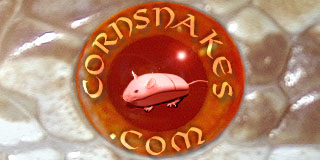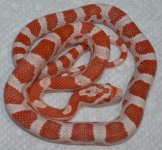Hello and welcome!
There is a plethora of information on this forum! Using the "search" function will direct you to what you are looking for, and if by chance, you cannot find what you are looking for, be sure to ask!
There is a lot of combined experience on here, and with some parts of reptile keeping, there is not just one way to do it, so try not to get frustrated.
I like to get my snakes from "smaller" breeders, who can give you more personal service.
Even though he is one of the biggest breeders, I still consider Steve Roylance one of those who gives personal service. He produces amazing babies (twice a year!). I have a number of snakes from him.
Depending on what you are looking for, there will be someone (breeder) here who has or will have what you like.
Nanci (SnickerSnakes) has some of the best Candy Cane babies!
I got this male from her last year.
Mites can be a problem, but if you are careful, you shouldn't have to worry about it too much.
Be careful at reptile expos, you can pick them up there. Sometimes, a vendor will have them on animals they bring, or sometimes people will bring their own pets (they're not supposed to). I always wash my clothes and shower after one, before going into my snake room.
They can be picked up and transported on your clothes from any source that has mites.
Check your new snake very carefully when you get it. It can be a good idea to keep the new snake on paper towels at first, so you can easily spot them.
I don't mean to scare you, but you should be vigilant about it, even with just one snake. I had them once, on a snake I brought in. Luckily, he was quarantined, so my other snakes were not affected.
Getting your setup running before getting your snake is the best way to go.
Make sure to get a thermostat to regulate the heat source. UTH (under tank heater) is the most commonly used, but depending on the size of enclosure, and the ambient temps in your house, you may not need heat during warmer season, or may need to add an additional heat source such as a ceramic heat bulb if the house gets too cold.
I use F10 or Maxima 256 for deep cleaning (and wash with soap and water, rinse well after) but for quick cleaning, I use 50/50 vinegar/water.
I use paper towels for my hatchlings, and then aspen for the older ones.
I spot clean as needed, and then do a whole change out of substrate as needed.
Many use the Munson Plan for a feeding guide.
This is what I use:
Snake wght freq. prey size prey wght
4-15gr 5-6days pinks 2-3gr
16-23gr 5-6days dbl. pinks 3gr X2
24-30gr 6-7days sm fuzzy 5-7gr
30-50gr 6-7days fuzzy 7-9gr
51-90gr 6-7days hopper 9-12gr
91-170gr 7days weanling 14-20gr
170-400gr *7days adult 20-30gr
401+ *7days xl adult 30-50gr
I calculated out the snake weight X .2= prey size weight (approximate) adjust as necessary.
My males get fed every 2-3 weeks, depending on their body condition.

